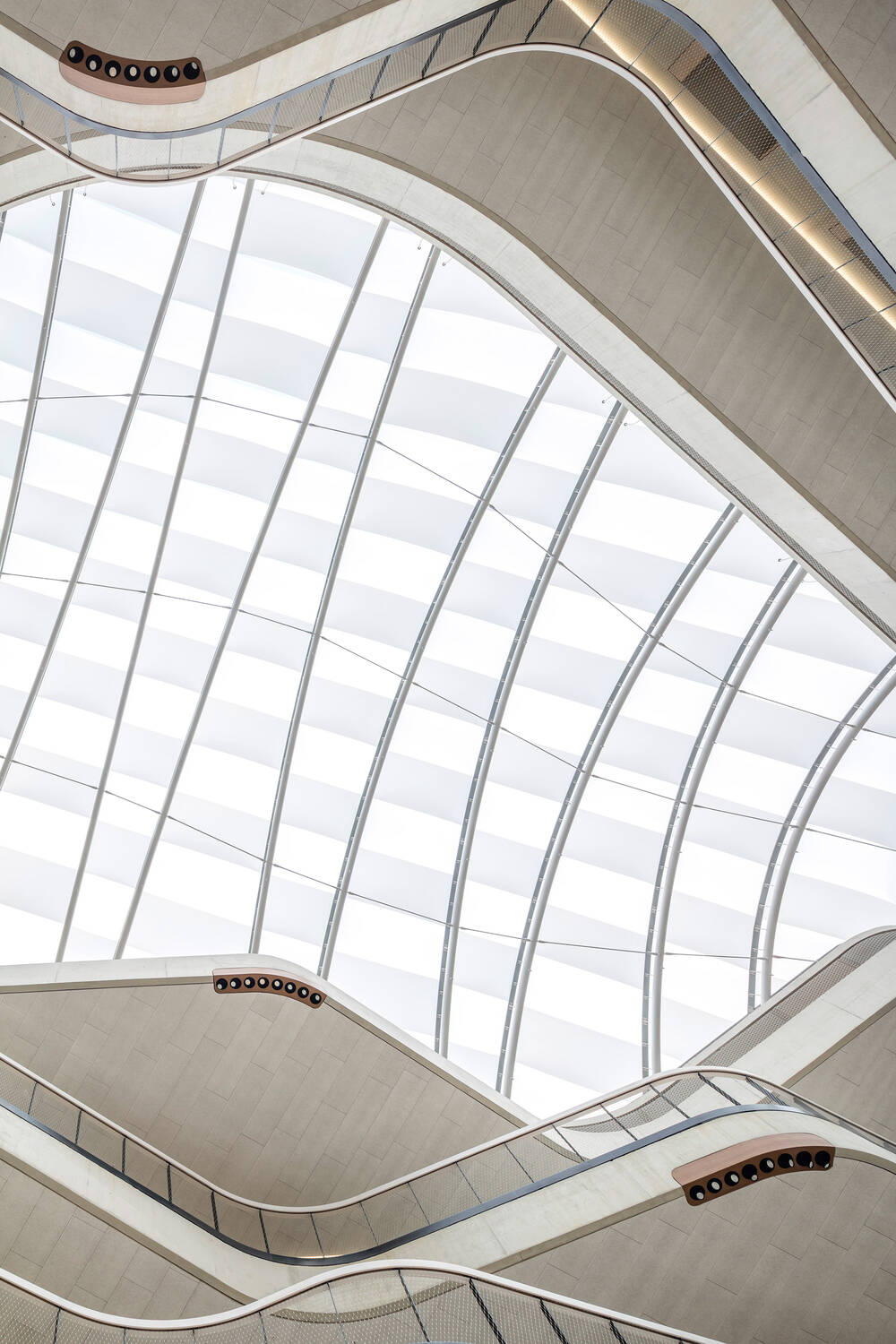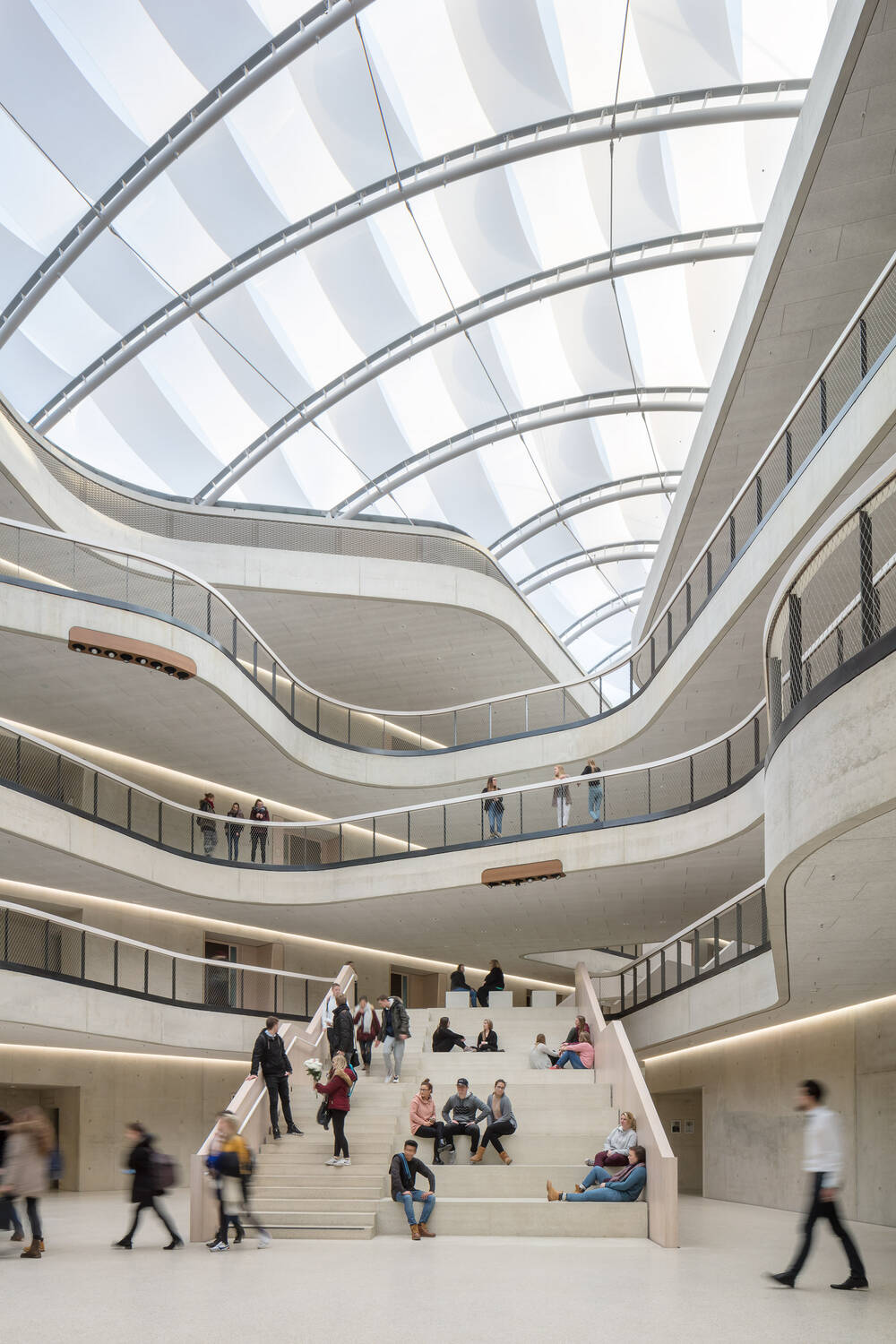The three former school locations Am Sachsenring, Am Krieler Dom and Klosterstraße are united under one roof in the new building of the Erzbischöfliches Berufskolleg on Berrenrather Straße in Cologne-Sülz. Since the start of the 2016-2017 school year, teaching and learning has been taking place here in a building with an exceptional architectural and interior design by 3pass (architecture) and KEGGENHOFF | PARTNER (interior design special areas). The building offers a wide range of opportunities for this.
EBK - Architektur und pädagogischer Raum
Giving space to diversity -
Architecture and pedagogical space at EBK Cologne
When you enter the school building, the unexpected happens: the foyer, designed as an atrium, opens up. As you enter, you have a feeling of space, height, light, openness and freedom in the wide, high-ceilinged room, which consists of the atrium and the stairwell and is topped by a translucent roof. There are no limits to thoughts and creativity here, intellectual flights of fancy are permitted.
The staircase, which narrows towards the top, welcomes the pupils, students and teachers coming from the various locations with their different traditions, embraces them like the colonnades of St. Peter's Square and leads them along a common path to the floors where teaching and learning take place together.
Geometrically, there is no center of the school building, the atrium is the "felt" center, it is something intangible, it is emptiness, pure space, which is filled by the common perspective of all those who shape learning and teaching in this building.
The architecture contains apparent contradictions that set people in motion: it simultaneously conveys the feeling of being inside and outside, it surrounds us with friendly protection and yet opens generously towards the sky, it offers a safe retreat and yet creates contact and closeness.
From the outside, the building appears rather restrained and serious in its design, giving no hint of the buoyancy of the interior with its various curves in the floors and balustrades.
The vaulted roof seems to be spanned by woven waves, cloud images can be observed through the lenticular openings. Movement is the predominant motif of the interior, being in motion and letting oneself be moved is the motif of those who open up the world and share and shape it with others.
Note: The text is based on the opening speech by Judith Kusch/3pass Architekt:innen.

Art on the building
Cologne artist Volker Saul has installed 15 stylized leg shapes in the three stairwells, each with five floors. They are color-painted, up to 260 cm tall aluminum cuts mounted on the wall with the title IN MOTION.
The work addresses the function of the location and, in a figurative sense, the phase of life of the pupils and students: The moving and moving learning and development phase between school and career entry. "Movement" can thus be understood in the sense of change, "progression" and development. Pupils and students are addressed through humor and emotionality with a visual language that is familiar to many from their living environment, the formal language of comics.
The leg elements are positioned on the wall surface "in the cut", so to speak, so that they seem to protrude from the architecture at different points. The curved organic leg shapes echo the vibrations of the floors in the large main hall. The surface of the objects and paint finish in traffic yellow corresponds with the materiality and aesthetics of the exposed concrete walls.
The pedagogical space -
Building spaces
The architecture and interior design of the building have created a pedagogical space that enables a lively process of teaching and learning. The training and further education of social and curative education specialists in vocational and study-related courses in particular requires "being in motion" and a change of perspective in diverse relationship systems.
In the words of Martin Buber:
I only recognize my own I in dialogue with the YOU.
The pedagogical space - it measures the distances between things, between the I and the YOU. Space - it can be filled.
We can place things and relationships in it.
We live from an inner space that occupies places in the outer space, centers itself there by opening up axes to the outside and gaining perspectives.
Impression and expression, taking in and giving out thus have a spatial structure.
We "fill" ourselves with external impressions and views, with perceptions and sensations and gain "inner" substance.
Conversely, we "fill" the outer space with movements, activities, meaning and significance.
Space as a didactic place of self-active, self-organized, exploratory learning. What is meant by this?
It is about the didactic understanding of teaching and learning, which is reflected in the basic pedagogical attitude of the teachers and in the diverse learning organization, to take back the instructive teaching and to challenge the activities of learning in the sense of self-education.
Pupils and students work less according to instructions in scenarios, but are challenged by professional learning and action situations to make their own decisions, to plan and organize their learning, to take greater responsibility for their own skills development and to think about their learning in a meta-reflexive way. Teachers become learning process facilitators here.

Space for collaborative learning and living -
Experience and discovery space
Social learning is challenged when we deepen the relationship to ourselves, to others, to the contents and to time; when diverse forms, contents and processes invite us to communicate and cooperate.
The diversity of sociality succeeds in variable arrangements in the classroom as well as in other communication and cooperation spaces:
Open learning zones, self-learning center/library, corridors, schoolyard, cafeteria, the adjacent church of St. John XXIII and especially in the pulsating heart of encounters - the atrium. John XXIII Church and especially in the pulsating heart of encounters - the atrium.
Social learning is also challenged when school sees itself as a living space, as a participatory space in which tasks, processes and problems can be communicated and solved together with pupils and students. Contacts, relationships and networks are formed and practiced both internally and externally with our diverse cooperation partners.
We see the training and further education of social and special education professionals as training in dialog, a jointly responsible form of teaching and learning at the school and practice learning locations.
"We think we make experiences, but experiences make us" (Eugène Ionesco)
Learning requires one's own experience, movement, activity, process and product in order to substantiate and justify these with meaning and significance in reflection.
Not only what we encounter in the learning process, but the learning movement itself becomes the object that is jointly considered, observed and reflected upon, in particular in the sense of the double didactics of mediation in relation to itself and the addressees of educational action.
Text: Indra Hofmeier-Pollak and Birgit van Elten for the Erzbischöfliche Berufskolleg, Cologne from "EBK - Der Vielfalt Raum geben" (Source)
Photo: Constantin Meyer Fotografie
More on interior design by KEGGENHOFF | PARTNER here